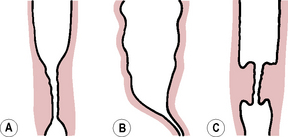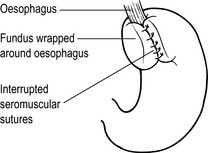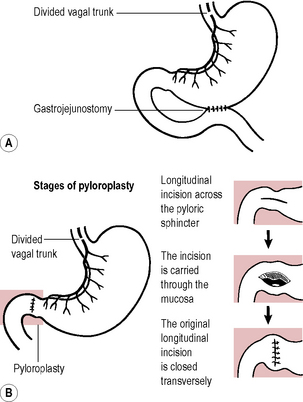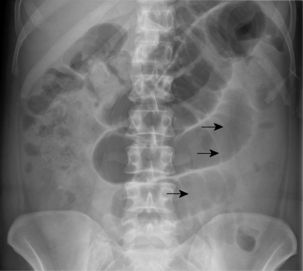CHAPTER 14 Alimentary tract
Oesophagus
Most conditions of the oesophagus have dysphagia as a symptom. Dysphagia is difficulty in swallowing. It may result from local or general causes (→ Table 14.1).
| Local | |
| In the lumen | Foreign body |
| In the wall | Congenital atresia |
| Inflammatory stricture – reflux oesophagitis | |
| Caustic stricture | |
| Achalasia | |
| Carcinoma | |
| Plummer–Vinson syndrome (oesophageal web) | |
| Scleroderma | |
| Irradiation | |
| Outside the wall | Mediastinal lymphadenopathy |
| Bronchial carcinoma | |
| Retrosternal goitre | |
| Pharyngeal pouch | |
| Para-oesophageal (rolling) hiatus hernia | |
| Thoracic aortic aneurysm | |
| Dysphagia lusoria (vascular ring) | |
| General | Myasthenia gravis |
| Bulbar palsy | |
| Bulbar poliomyelitis | |
| Hysteria |
Inflammatory stricture
Hiatus hernia
There are two types: sliding (90%) and rolling or paraoesophageal (10%). In the rolling type, the cardio-oesophageal mechanism is intact and therefore reflux does not occur. The stomach rolls up alongside the lower oesophagus pressing on it and causing dysphagia (→ Fig. 14.1).
Sliding hiatus hernia
The stomach slides through the hiatus and therefore the position of the cardio-oesophageal junction changes and reflux occurs (→ Fig. 14.1).
Investigations
Treatment
Surgical
Indicated for failed medical treatment or complications, e.g. anaemia or severe dysphagia due to stricture. Surgery may also be indicated for young patients who do not want to take long-term acid-suppressant agents. There are several operations but a Nissen fundoplication (→ Fig. 14.3) is the most commonly performed. The hernial defect is repaired and the mobilized fundus of the stomach is wrapped around the lower end of the oesophagus to provide an antireflux mechanism. This may be done by the ‘open’ or laparoscopic method.
Achalasia
Carcinoma of the oesophagus
Stomach and duodenum
Peptic ulceration
Investigations
Treatment
Medical
Surgical
Indications are the following:
Carcinoma of the stomach
Gastric surgery and its complications
Operations
Complications
Bilious vomiting
Sudden emptying of the afferent loop with Billroth II. Associated biliary gastritis. May respond to metoclopramide. Severe cases need revisional surgery, e.g. Roux-en-Y anastomosis so that bile enters the GI tract lower down in the jejunum (→ Fig. 14.6).








 In infants, diarrhoea and vomiting may be the only symptoms. This may lead to difficulty in diagnosis and confusion with gastroenteritis. In elderly patients there may be confusion and later, shock may develop.
In infants, diarrhoea and vomiting may be the only symptoms. This may lead to difficulty in diagnosis and confusion with gastroenteritis. In elderly patients there may be confusion and later, shock may develop.

